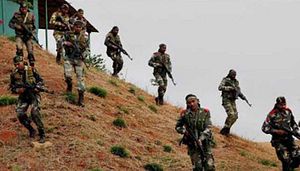The Sukma region in the Indian state of Chhatisgarh, the site of one of the most volatile internal conflicts in the country, saw a deadly attack on April 24, 2017. In this region that sees constant clashes between the state security forces and Naxal/Maoist groups, the Central Reserve Police Force (CRPF) troops faced an ambush that left 26 soldiers dead and multiple injured. In the narrative that emerged through the survivors in the days following the attack, the Naxal attackers were heavily armed. The attackers, estimated to be around 300, first sent ahead villagers into the scene to lure the CRPF troops and then reportedly swept in for the ambush.
Top officials of the ruling government, including Prime Minister Narendra Modi, who tweeted his condolences and declared that their sacrifices would not go in vain, condemned the attack, which shook the region. Union Home Minister Rajnath Singh called it cold-blooded murder and promised an immediate investigation. The state of Madhya Pradesh declared a high alert in its own Naxal belts, while the state of Odisha sealed its border, temporarily fearing a spillover. Tamil Nadu. Bihar, West Bengal, and Punjab have already offered compensation to the families of the affected soldiers.
The initial investigation throws up two rather worrying results. First, this act may have occurred as a result of temporary lapse in concentration of the forces, who let their position guard down long enough to allow an ambush. Second, that the weaponry used by the Naxals, which included bows and arrows, had a frightening degree of sophistication. Parallels have been drawn to a Naxal attack in 2010 when 74 CRPF soldiers were killed. The investigation also attempts to look at what lessons have still not been learnt.
The lead up to the attack was reportedly not a smooth one, as some investigations indicate that the number of security forces killed in Chhatisgarh in 2017 so far was reportedly more than the five-year average. In the conversation following the Sukma attack, dissatisfaction with the central government’s attitude towards the CRPF has been clear. Security experts have pointed out that for around two months now the CRPF has not had a full-time director general. To add to this, they take predictable paths on major roads in Naxal-heavy areas and require a significant increase in intelligence capacity.
However, the conversation among politicians barely alludes to this. While Rajnath Singh has called for a vociferous switch in strategy, declaring that he is willing to give the forces anything they want if they can bring him results, the question of whether it took these many deaths for a strategy overhaul begs an answer. While the central government has declared its all out offensive, the conversation at this point seems to be about revenge and assigning blame. Minister for Information and Broadcasting Venkaiah Naidu has said that the attackers have the tacit support of human rights advocates in the region and even reportedly called for public action against activists.
Deflecting from the dialogue on what shortcomings exist and what contributed to the lapse that allowed this to occur is hardly useful and this sort of rhetorical blame game merely feeds dissatisfaction. The opposition parties have further attempted to square the blame upon the center for the intelligence shortfall. In the meanwhile, Maoist groups have claimed responsibility for the attack, calling it a retaliation for the security forces’ attack on some of their members, as well as their abuse of tribal women.
The reactions in the wake of this attack have been problematic on multiple counts. The most obvious problem has been the revenge narrative and blame game that followed, where the need to save face and assuage popular outrage appears to have taken center stage over owning up to problems. Successive governments have dropped the ball in a manner that led to the situation Chhatisgarh. Unless the response to Sukma takes that into account, no reasonable steps can be taken going forward.
Knee-jerk reactions and immediate promises to suddenly intensify support further run the risk of devolving into paper tigers. Finally, in attempting to recover from this, both the center and the state governments must recognize that while violence as a means of expressing outrage cannot be condoned, dismissal of at least some Naxal concerns like tribal abuse at the hands of the troops is hardly fruitful either. Some careful deliberation is required and the traditional defensiveness of the state in the wake of the attack can prove devastating to the attempt to forge a sustained conflict resolution mechanism.

































